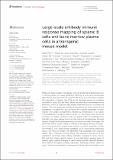Large-scale antibody immune response mapping of splenic B cells and bone marrow plasma cells in a transgenic mouse model
Author(s)
Pan, Xiaoli; López Acevedo, Sheila N.; Cuziol, Camille; De Tavernier, Evelyn; Fahad, Ahmed S.; Longjam, Priyobarta S.; Rao, Sambasiva P.; Aguilera-Rodríguez, David; Rezé, Mathilde; Bricault, Christine A.; Gutiérrez-González, Matías F.; de Souza, Matheus Oliveira; DiNapoli, Joshua M.; Vigne, Emmanuelle; Shahsavarian, Melody A.; DeKosky, Brandon J.; ... Show more Show less
Downloadfimmu-14-1137069 (1).pdf (4.171Mb)
Publisher with Creative Commons License
Publisher with Creative Commons License
Creative Commons Attribution
Terms of use
Metadata
Show full item recordAbstract
Molecular characterization of antibody immunity and human antibody discovery is mainly carried out using peripheral memory B cells, and occasionally plasmablasts, that express B cell receptors (BCRs) on their cell surface. Despite the importance of plasma cells (PCs) as the dominant source of circulating antibodies in serum, PCs are rarely utilized because they do not express surface BCRs and cannot be analyzed using antigen-based fluorescence-activated cell sorting. Here, we studied the antibodies encoded by the entire mature B cell populations, including PCs, and compared the antibody repertoires of bone marrow and spleen compartments elicited by immunization in a human immunoglobulin transgenic mouse strain. To circumvent prior technical limitations for analysis of plasma cells, we applied single-cell antibody heavy and light chain gene capture from the entire mature B cell repertoires followed by yeast display functional analysis using a cytokine as a model immunogen. We performed affinity-based sorting of antibody yeast display libraries and large-scale next-generation sequencing analyses to follow antibody lineage performance, with experimental validation of 76 monoclonal antibodies against the cytokine antigen that identified three antibodies with exquisite double-digit picomolar binding affinity. We observed that spleen B cell populations generated higher affinity antibodies compared to bone marrow PCs and that antigen-specific splenic B cells had higher average levels of somatic hypermutation. A degree of clonal overlap was also observed between bone marrow and spleen antibody repertoires, indicating common origins of certain clones across lymphoid compartments. These data demonstrate a new capacity to functionally analyze antigen-specific B cell populations of different lymphoid organs, including PCs, for high-affinity antibody discovery and detailed fundamental studies of antibody immunity.
Date issued
2023-06-05Department
Massachusetts Institute of Technology. Department of Chemical Engineering; Ragon Institute of MGH, MIT and HarvardPublisher
Frontiers Media SA
Citation
Pan X, López Acevedo SN, Cuziol C, De Tavernier E, Fahad AS, Longjam PS, Rao SP, Aguilera-Rodríguez D, Rezé M, Bricault CA, Gutiérrez-González MF, de Souza MO, DiNapoli JM, Vigne E, Shahsavarian MA and DeKosky BJ (2023) Large-scale antibody immune response mapping of splenic B cells and bone marrow plasma cells in a transgenic mouse model.
Version: Final published version
ISSN
1664-3224
Keywords
Immunology, Immunology and Allergy
Collections
The following license files are associated with this item: